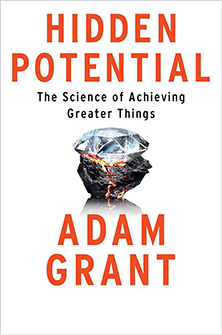
Rethinking Potential
Thursday, May 2, 2024
Strategies for developing character and achieving progress in a chaotic business environment.
The landscape for the future of work is messy and chaotic. Forbes identifies “adapting to change and uncertainty” as a critical challenge for 2024.1
Technology (especially AI, artificial intelligence) is rapidly reshaping production and business models, mainly in unforeseen ways. Remote work and hybrid work are reshaping operational models; social policies on climate, diversity and inclusion (DEI), and environment, sustainability and governance (ESG) — made more challenging by polarized political sentiments — are whipsawing the foundational values for both business strategy and vision. With such an obscure and uncertain future, what’s best may never be known.
The title of Adam Grant’s new book, Hidden Potential, is particularly apt for this current business environment, where tools for discovering value, developing high-performing cultures and fostering future leaders will be at a premium.
The subtitle, The Science of Achieving Greater Things, signals two fundamental values: science (insights bolstered by studies identifying behaviors more likely to achieve desired results) and achievement (our desire to make progress and overcome obstacles to perform).
Is the emergence of a high-performing organization random? Those of us who have been blessed to be part of highly effective organizations can see that the team benefited from talented and accomplished members. As in radio storyteller Garrison Keillor’s fictional Lake Wobegon, where all the children are above average, some teams have the good fortune to be populated with better-than-average individuals. But in the real world, teams will begin with average players and circumstances, and we cannot rely on random events to create a better-than-average outcome.
Underlying Value Ideology: Grant’s Foundation
In addition to science and achievement, Grant builds on character. Grant makes the case that character is not innate but can be strengthened, expanded and improved. We are capable of self-transformation — we can get better, we are capable of mastery, and our employees, our teams and our organizations are all capable of the same growth and improvement.

Hidden Potential The science of Achieving Greater Things by Adam Grant, Viking, October 23, 2023.
It should be noted that Hidden Potential devotes a significant portion of its text to applying these principles of character and development to theories of primary education and our school systems. To read the prologue is to have a quick course in rearing children that will resonate with any parent or grandparent of a fourth grader.
Grant writes: “Character is often confused with personality. … Character is your capacity to prioritize your values over your instincts. … If personality is how you respond on a typical day, character is how you show up on a hard day. Personality is not your destiny — it’s your tendency. Character skills enable you to transcend that tendency to be true to your principles. It’s not about the traits you have — it’s what you decide to do with them. Wherever you are today, there’s no reason why you can’t grow your character skills starting now.”
How do we build these skills? First, Grant frames the discussion in terms of skills — something that can be learned, honed, strengthened and improved — instead of a trait one has or does not have. This framing is essential not only for his advice on building one’s own skills, but also for the way it opens the door for leaders to think about employees, potential hires and future leaders.
Grant offers a variety of ways to improve your character skills:
- Become a creature of discomfort: Don’t be afraid to try a new style.
- Seek discomfort: Instead of merely striving to learn, aim to feel discomfort, which sets you on a faster path to growth.
- Become a sponge: Seek out new knowledge to fuel your growth; ask for advice from others.
- Own your new skills and knowledge by putting them to use, possibly before you feel you are ready, and in being a coach to others, be the type of coach you would hope to have.
- Be an imperfectionist: Strive for excellence, not perfection; enlist judges to gauge your progress.
Grant’s advice may begin to sound like, “Pull yourself up by your own bootstraps.” But his vision for self-improvement does not have to be a grinding slog of self-punishment. Grant uses the metaphor of building a scaffolding — a temporary structure to scale unreachable heights and climb barriers. For example:
- Turn practice into play: Find ways to turn the daily grind or fixed routine into a source of daily joy.
- When you’re stuck, move back to move forward: Even though it might feel like regressing, sometimes going backward and discovering a new path is the right move. (Golfers know sometimes the way out of the bunker is not always towards the hole.)
- Find a side gig: Build momentum by taking a detour to a new destination. Small wins in a new endeavor can inspire you to make headway in other projects.
Expand the character-building metaphor to the entire organization. Grant also argues his vision for self-improvement applies to the organization as a whole. Leaders should build systems of opportunity.
Unearth Collective Intelligence in Teams
“The best teams aren’t the ones with the best thinkers. They’re the teams that unearth and use the best thinking from everyone.”3
- Choose leaders based on prosocial skills. Collective intelligence is harnessed through cohesion, clarity and shared mission. Leaders who articulate values and promote behaviors that access non-obvious or unintuitive thinking will fosterbetter teams.
- Engage in “brainwriting” rather than brainstorming. Brainwriting calls for everyone to write down ideas independently, as opposed to tossing up ideas in a group setting. Ideas are then discussed without knowing who authored them. This method avoids several systematic barriers to brainstorming where “groupthink” or dominant personalities hinder creativity, less assertive members are not heard or herd instinct rushes to judgment before all ideas are aired.
- Replace the corporate ladder system with a lattice system. Why have only one mentor? Why not have several? Why force ideas and communication through a vertical silo system when creativity and cross-pollination can invigorate creativity?
Reimagine How We Evaluate Talent
- Account for the degree of difficulty. Does someone struggle due to a lack of ability or due to the presence of adversity? We should admire scaling a 1,000-foot cliff from the bottom of a ravine as much as we do a 1,000-foot climb up a mountain.
- Use trajectories in evaluations — both in recruiting and performance. Candidates showing steady GPA improvement throughout studies prove to be more successful than those whose trend line was downward at graduation.
- Redefine success — the most meaningful form of performance is progress. A base runner who steals two bases to get to third may hold more promise than a base runner scoring easily from third.
Counterpoint
Grant undergirds his advice with excellent stories about people overcoming extraordinary obstacles. For example, a deaf person becomes a world recognized percussionist-composer; a migrant worker becomes an astronaut; a diminutive girl from Arizona scales Mount Everest; a 24-year-old engineer who was not part of the core team suggests the eventual rescue solution to the Chilean mining disaster.
A theme throughout these stories is that the person at the center of success would have yet to be identified through our usual sorting criteria of obvious talent, experience or sterling credentials. Instead, each exemplifies persistence and character — repeated exertion after multiple setbacks.
Where does this fit in with some of the old tried and true maxims of the past? For example, “the ‘very good’ is the enemy of the ‘best’” or “why not the best?” If we subscribe to imperfectionism, doesn’t that guarantee a future of settling for the mediocre? Aspiring to be the best is highly motivational, and such motivation might propel us through adversity.
Accountability becomes very murky as well. If we prize stealing two bases over scoring from third base, do we lose our focus on scoring a run? Do people game the system, knowing the appearance of progress is valued over absolute results, and sandbag performance to set a low base, only to appear to have overcome a great distance later?
We are asked to open doors for people who are underrated and overlooked. This is a departure from Jack Welch’s tenure at General Electric, where he insisted on firing the bottom 10 percent of performers yearly. Of course, Neutron Jack’s legacy has grown a lot of tarnish in recent years, but it still begs the question of how to cull underperformers.
Conclusion
Leaders and managers may need to consider if Grant’s shift in mindset carries the risk of losing focus on important milestones. But “scoring a run from third base” has a clarity and singularity not found in today’s messy business environment, where we may not be sure if we are playing baseball or soccer.
And if we are playing baseball today, we may find our business depends upon playing soccer tomorrow. Grant’s book offers terrific insights into building a team of versatile, agile and resilient athletes and teams for whatever game emerges in the years to come.
1. The Top 4 Skills Leadership Teams Will Need In 2024, The New York Times, Byline of Brent Gleeson Dec 29, 2023.
2. Page 20. Adam Grant, Hidden Potential, Viking 2023.
3. Page 179
This article originally appeared in the Spring 2024 issue of In the Lead magazine, from Stillman School of Business’s Department of Management and the Buccino Leadership Institute. The bi-annual magazine focuses on leadership perspectives from the field of health care, with content that is curated from leaders across the industry who share lessons learned from real-world experiences.
Categories: Business, Science and Technology

